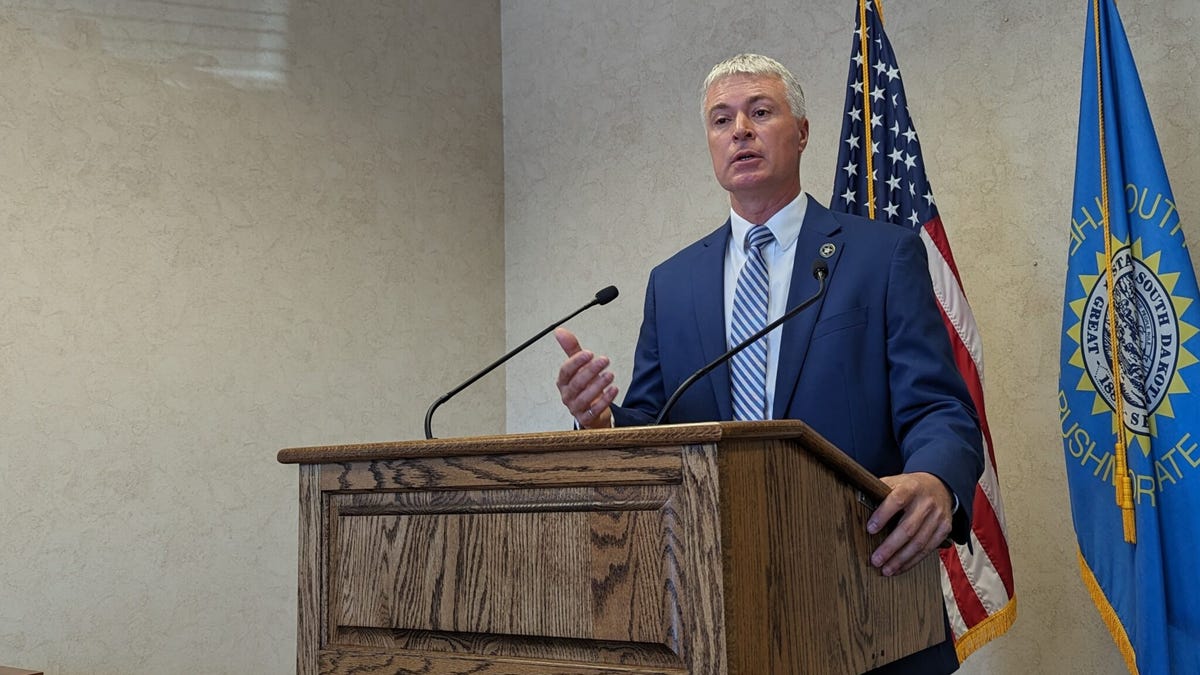North Carolina
As Biden visits renamed N.C. military base, DeSantis slams ‘political correctness run amok’

NORTH CAROLINA — President Joe Biden traveled to the recently renamed Fort Liberty in North Carolina on Friday to sign an executive order that aims to bolster job opportunities for military and veteran spouses whose careers are often disrupted by their loved ones’ deployments.
Less than 100 miles away at the state’s Republican Party convention, GOP presidential contender, Florida Gov. Ron DeSantis, vowed to restore the former name of the base that until last week was called Fort Bragg in honor of a Confederate general, if voters elect him president.
“It’s an iconic name and iconic base, and we’re not gonna let political correctness run amok in North Carolina,” DeSantis said at the convention in Greensboro hours after Biden’s speech and signing ceremony at Fort Liberty.
The installation’s former name honors Gen. Braxton Bragg, a North Carolinian, who was known for owning slaves and losing key Civil War battles that contributed to the Confederacy’s downfall. Biden made no mention in his remarks before hundreds of soldiers and their spouses about the renaming of the base which was formally done by military officials last week.
The renaming of the base was part of a broader effort by the U.S. military to confront racial injustice in the aftermath of the May 2020 police killing of George Floyd in Minneapolis. An independent commission last year recommended new names for Bragg and eight other Army posts that commemorate Confederate officers.
The installation is the largest U.S. Army base by population, with roughly 47,000 active-duty soldiers. The recent renaming didn’t play a role in selecting the base to serve as a backdrop for Biden to announce his executive order, according to an administration official who was not authorized to comment and spoke on the condition of anonymity.
The Biden campaign did not immediately respond to a request for comment.
In addition to DeSantis, former Vice President Mike Pence and former President Donald Trump, the current GOP front-runner, are scheduled to address delegates on Saturday at the state convention in Greensboro. Trump, who has been indicted on charges of mishandling classified documents at his Florida estate, is also slated to speak on Saturday to the Georgia Republican Party’s convention.
The order Biden signed on Friday directs agencies to develop a federal government-wide strategic plan on hiring and job retention for military spouses; bolster child care options; improve the collection of data on military and veteran spouses, caregivers and survivors in the federal workforce; and more than a dozen additional actions.
In remarks shortly before signing the order, Biden noted that the U.S. next month will mark 50 years of the all-volunteer force, which the president proclaimed the “greatest fighting force in the history of the world, bar none.”
“The reason we’ve been able to sustain that force year after year, decade after decade, is because military spouses, caregivers and survivors have answered the call as well,” Biden said. “You have your loved ones’ backs, just like they have the country’s back.”
Biden was accompanied by first lady Jill Biden, whose “Joining Forces” initiatives focuses on aiding military families. She said that while the new executive order is a step forward, employers must also do their part by hiring military spouses and offering their families support.
“Spouses bring experience and adaptability that really can’t be taught,” Jill Biden said. “And when they get the opportunities that they deserve, our service members can do their duty knowing that those they love most are able to thrive”
The order was largely framed by conversations through the first lady’s initiative, which looks to support families, caregivers and survivors of members of the U.S. military, Jill Biden said on a call with reporters previewing the order.
With nearly one in five military families citing challenges with spousal employment as a reason for considering leaving active-duty service, the issue is no small matter for the military’s recruitment and training efforts, according to the White House. More than 16,000 military spouses work within the federal government.
“We’re asking agencies to make it easier for spouses employed by the federal government to take administrative leave, telework and move offices,” the first lady said. “We’re creating resources to support entrepreneurs. And the executive order helps agencies and companies retain military spouses through telework or when they move abroad.”
Before their visit to Fort Liberty, the Bidens took a tour and met with students at Nash Community College in Rocky Mount, North Carolina. The school is part of a coalition that received $23.7 million to train students for clean energy jobs from Biden’s $1.9 trillion coronavirus relief package.
Biden said the job training effort is part of a strategy to “make us once again the most competitive nation in the world.”

North Carolina
North Carolina's starters with Seth Trimble back still unclear

Posted Jan 11, 2025
Who will Coach Hubert Davis start with the return of Seth Trimble and the continued ascent of freshman Ian Jackson? Trimble came off the bench in Tuesday’s win over SMU because the junior guard had only practiced once and hadn’t played since Dec. 21. If Trimble returns to the starting lineup for UNC at N.C. State, it isn’t clear who else will start.
(Tar Heel Tribune)
Basketball, Basketball Recruiting
Video: Locked On Tar Heels – UNC’s Identity Still a Work in Progress; How to ease Seth Trimble back?
With Seth Trimble’s return from injury, UNC is making strategic lineup adjustments, while Jalen Washington’s development is a key focus. Isaac Schade and Bill Robinson…
Sat Jan 11, 2025
Drake Powell Settling in as Starter for UNC Basketball
UNC returned from the Maui Invitational at 4-3 and riding a two-game losing streak. A slow start for the Tar Heels prompted coach Hubert Davis…
Sat Jan 11, 2025
UNC basketball vs NC State: Score prediction, scouting report for Tar Heels-Wolfpack
UNC and N.C. State meet this weekend for the first time since the championship game of the 2024 ACC Tournament. Both teams were hoping for…
Sat Jan 11, 2025
Zayden High Returns to School at UNC, Remains Off Basketball Team
Although he will not rejoin the basketball team this season, 6-foot-10 forward Zayden High is enrolled at North Carolina taking classes for the spring semester…
Fri Jan 10, 2025
North Carolina
Snow drought ends: Parts of central NC gets first measurable snowfall in 2 years | Live

The North Carolina Department of Transportation gave an update Friday afternoon on its preparations and strategies for managing roadways before, during and after the winter storm.
Doug McNeal, division maintenance engineer for NCDOT’s Division 5, said NCDOT has been preparing for this during the past three days.
Division 5 covers Durham and Wake counties as well as surrounding counties up to the Virginia line.
“We’ve had about 65 salt-brine applicators out in the division. We’ve put out roughly 465,000 gallons in our division,” McNeal said.
Statewide, more than 3 million gallons have been put down.
“We’re expecting impacts across pretty much all of North Carolina. Right now, we’re transitioning to our response time,” McNeal said. “We’re starting to see a little bit of snow in the air … but it’s certainly going to get treacherous out there.”
He said 110 DOT trucks and motor graders are ready to go and an additional 150 contract trucks are loaded and staged.
“As it starts to roll in, we generally wait until you can see tracks in the road before we start taking in, applying salt,” McNeal said. “If you apply before then, it just bounces off the roads, so you need a little bit of material there to capture it but once we give it a little bit of time to activate, and we’re plowing from there.”
He said another concern with this storm is the potential for freezing rain.
“We’re seeing forecasts potentially up to a quarter-inch of ice in the area,” McNeal said.
They’ve also staged what McNeal called cut-and-shove crews.
“We’ll take and try to cut it back to the edge of the pavement and then push off everything else so that the lanes are open and then we come back after things warm up in a couple of days and clear it up from there,” he explained.
McNeal said Saturday would be a good day for people to sleep in and “enjoy that cup of coffee before you go out.”
North Carolina
North Carolina Governor Josh Stein declares state of emergency ahead of winter storm

(WGHP) — Governor Josh Stein declared a statewide state of emergency on Thursday evening ahead of a winter storm expected to sweep through the Piedmont Triad on Friday.
He is urging people across North Carolina to prepare for cold temperatures, snow and ice.
“This storm will likely bring significant impacts from snow, sleet and freezing rain in different parts of the state,” Stein said. “North Carolinians should pay close attention to their local weather forecast, make sure they are prepared with what they need at home before Friday afternoon and stay home if possible as ice on the roadways will likely create dangerous driving conditions.”
On Wednesday, Stein activated state resources to set into motion a cross-agency storm response and enable the potential of federal reimbursement if the event qualifies.
The North Carolina Department of Transportation has begun brining roads. They will work around the clock in 12-hour shifts to plow and treat snow and ice until all state-maintained roads are cleared.
“State emergency officials are monitoring the situation and are prepared to assist the counties and municipalities if needed,” NC Emergency Management Director Will Ray said. “Residents across the state should be prepared to shelter in place. If the power goes out, be sure to operate generators outside and away from open windows or doors to prevent carbon monoxide poisoning.”
-

 Sports1 week ago
Sports1 week agoThe top out-of-contract players available as free transfers: Kimmich, De Bruyne, Van Dijk…
-

 Politics1 week ago
Politics1 week agoNew Orleans attacker had 'remote detonator' for explosives in French Quarter, Biden says
-

 Politics1 week ago
Politics1 week agoCarter's judicial picks reshaped the federal bench across the country
-

 Politics7 days ago
Politics7 days agoWho Are the Recipients of the Presidential Medal of Freedom?
-

 Health6 days ago
Health6 days agoOzempic ‘microdosing’ is the new weight-loss trend: Should you try it?
-

 World1 week ago
World1 week agoSouth Korea extends Boeing 737-800 inspections as Jeju Air wreckage lifted
-

 News1 week ago
News1 week ago21 states are getting minimum wage bumps in 2025
-
/cdn.vox-cdn.com/uploads/chorus_asset/file/25822586/STK169_ZUCKERBERG_MAGA_STKS491_CVIRGINIA_A.jpg)
/cdn.vox-cdn.com/uploads/chorus_asset/file/25822586/STK169_ZUCKERBERG_MAGA_STKS491_CVIRGINIA_A.jpg) Technology2 days ago
Technology2 days agoMeta is highlighting a splintering global approach to online speech


















